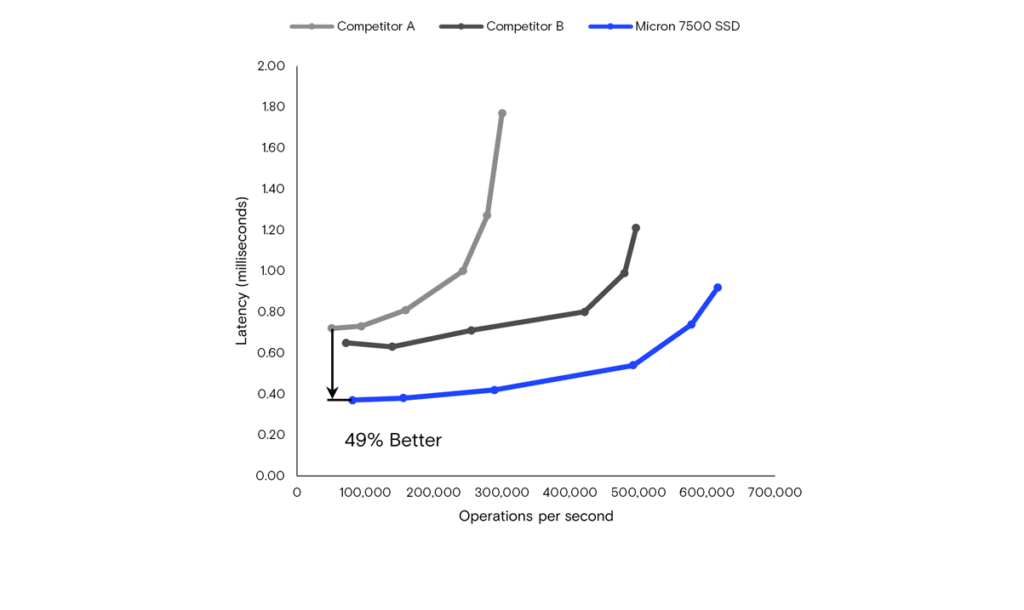How to obtain the most cutting-edge common Micron 7500 SSD for your data center
Do you wish to increase the effectiveness and performance of your data center? Do you wish to profit from 232-layer NAND memory technology and OCP 2.0 standards? Do you want to experience Gen4 speed that outperforms the competition, sub-1 millisecond latency, and 6x9s quality of service (QoS)?
The world’s most cutting-edge mainstream SSD, the Micron 7500 NVMe SSD, is what you need if you said “yes” to any of these inquiries. Learn all you need to know about this incredible drive and how to purchase one for your data center by reading on.
What is so unique about the Micron 7500 NVMe SSD?
A typical SSD is not the Micron 7500 NVMe SSD. It is a game-changer for data center storage because of its unique features and advantages that set it apart from the competition. For instance:
- Utilize Micron’s market-leading, state-of-the-art 232-layer NAND flash to give exceptional low latency, below 1 millisecond (ms), and high performance for 6x9s QoS, translating to dependable performance for your data center applications.
- With broad Open Compute Project (OCP) standards support, effectiveness, and security in a U.3 form factor, it is possible to integrate and operate OCP-compliant systems with ease.
- Delivering improved performance for workloads including databases, content delivery, real-time analytics, social media, cloud computing, and virtualization, speeding up your workloads and releasing the full potential of your data center.
The Micron 7500 supports OCP 2.0 standards in what ways?
The OCP SSD 2.0 specification2 is implemented by the Micron 7500 SSD to offer smart management, performance improvement, smooth integration, and error handling. Performance is boosted through latency monitoring, which makes it possible to track, identify, and fix latency problems.
Furthermore, administrative commands readily integrate with OCP-compliant management systems and provide standardized control over features like namespaces and security. Additionally, the OCP SSD 2.0 compatible error recovery and error injection capabilities of the 7500 SSD allow for quick drive recovery and simulation of problems that are frequently seen in data centers.
The Micron 7500 NVMe SSD supports the adoption of data security and broad compatibility with other OCP devices by embracing OCP 2.0 standards.
How is the data security for the Micron 7500?
With important security measures that shield your data from illegal access or manipulation, the Micron 7500 SSD helps keep your data secure. What the Micron 7500 NVMe SSD provides:
- Digitally signed firmware: Before an update, SSD firmware is authenticated to stop rogue firmware from loading.
- Cryptographic erasure: Enables quick and secure sanitization of user data that has been saved.
- Secure boot: Employs a chain of trust method to verify the legitimacy of each entity prior to execution, such as at power-on.
- Data-at-rest protection: Uses the cutting-edge cryptographic technique AES-XTS-256 to ensure the security of user data saved on NAND.
- Support for Security Protocol and Data Model (SPDM) 1.2 enables systems employing the Micron 7500 NVMe SSD to cryptographically confirm the drive’s identification and firmware integrity.
- Self-encrypting drives (SED) are encrypted under the supervision of the Trusted Computing Group (TCG) Opal.
- Hardware security engines: Uses SHA-512, RSA-4048, AES-256, and other encryption engines in certain SSDs. The Commercial National Security Algorithm (CNSA) Suite paper specifies a number of security requirements that these engines satisfy or surpass.
- A specialized security microprocessor that is electrically segregated from other microprocessors within the SSD controller makes up the Micron secure execution environment (SEE), whose execution cannot be interrupted by insecure code. Because of this isolation, it is far less likely that the storage device’s security features will be deliberately or mistakenly bypassed.
- The Micron 7500 NVMe delivers a secure drive for an Open Compute world with choices for FIPS 140-3 Level 2 and TAA compliance for U.S. federal government procurement regulations.
How does the 7500 NVMe SSD outperform its rivals in terms of performance?
One of the most crucial aspects of data center storage is performance. For applications that need low and stable latency to provide quick, dependable response, the Micron 7500 SSD is made. Results from internal Micron testing demonstrate latency < 1 millisecond with 6x9s QoS in workloads for 4K 100% random reads. We are developing a new class of widely used data center SSDs with latency that is now unmatched by our competitors:

Here are some graphs from our internal testing that demonstrate how the Micron 7500 NVMe SSD beats its rivals in terms of performance and QoS for 100% read and mixed workloads across a variety of workloads and block sizes when compared to competing SSDs:

Tests using RocksDB versus two top rivals show some notable differences and show how the Micron 7500 SSD performs better in RocksDB, for instance:

Across all measured thread counts (8 to 128), the Micron 7500 SSD provides better RocksDB 4KB block size performance (in both read and read while writing workloads), with maximum performance benefits up to 2.1 times random read while writing performance (see figure 2, above).
Additionally, tests revealed that reaction time gains for read-while-writing workloads are up to 49% better, as illustrated in figure 3 below.

These results demonstrate that the Micron 7500 NVMe SSD offers significant advantages for read-intensive and complicated mixed workloads, as well as dependable and stable performance for your data center applications.
How Can Your Data Center Get the Micron 7500 NVMe SSD?
You’re in luck if you want to purchase a Micron 7500 NVMe SSD for your data center. The drive is now shipping and may be tested. Don’t pass up this chance to own the most cutting-edge mainstream SSD in the world. Get your samples from us today and see the difference.


[…] greatest user experience is Micron’s top priority for every class of SSDs we manufacture. PC OEMs, game developers, and gamers can get […]